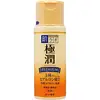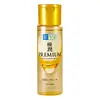What's inside
What's inside
 Key Ingredients
Key Ingredients

 Benefits
Benefits

 Concerns
Concerns

No concerns
 Ingredients Side-by-side
Ingredients Side-by-side

Tranexamic Acid
AstringentSodium Hyaluronate
HumectantHydrolyzed Hyaluronic Acid
Humectant3-O-Ethyl Ascorbic Acid
Skin ConditioningTocopherol
AntioxidantGlycerin
HumectantDiglycerin
HumectantDipropylene Glycol
HumectantSorbitol
HumectantPentylene Glycol
Skin ConditioningPPG-17 Butyl Ether
Skin ConditioningPolyglyceryl-10 Eicosanedioate/Tetradecanedioate
Skin ConditioningButylene Glycol
HumectantDiethoxyethyl Succinate
SolventPolyglyceryl-2 Hydroxypropyl Ethylhexyl Ether
CleansingSqualane
EmollientC4-18 Alkyl Methacrylate/Methacryloyloxyethyl Phosphorylcholine Copolymer
HumectantPetrolatum
EmollientCetearyl Alcohol
EmollientBehenyl Alcohol
EmollientXanthan Gum
EmulsifyingAcrylic Acid/C12-22 Alkyl Acrylate Copolymer
StabilisingPolyvinylalcohol Crosspolymer
PEG-20 Sorbitan Isostearate
EmulsifyingGlyceryl Stearate
EmollientEDTA
Melaleuca Alternifolia Leaf Oil
AntioxidantSodium Metabisulfite
AntioxidantPhenoxyethanol
PreservativeIodopropynyl Butylcarbamate
PreservativeSodium Paraben
PreservativeTranexamic Acid, Sodium Hyaluronate, Hydrolyzed Hyaluronic Acid, 3-O-Ethyl Ascorbic Acid, Tocopherol, Glycerin, Diglycerin, Dipropylene Glycol, Sorbitol, Pentylene Glycol, PPG-17 Butyl Ether, Polyglyceryl-10 Eicosanedioate/Tetradecanedioate, Butylene Glycol, Diethoxyethyl Succinate, Polyglyceryl-2 Hydroxypropyl Ethylhexyl Ether, Squalane, C4-18 Alkyl Methacrylate/Methacryloyloxyethyl Phosphorylcholine Copolymer, Petrolatum, Cetearyl Alcohol, Behenyl Alcohol, Xanthan Gum, Acrylic Acid/C12-22 Alkyl Acrylate Copolymer, Polyvinylalcohol Crosspolymer, PEG-20 Sorbitan Isostearate, Glyceryl Stearate, EDTA, Melaleuca Alternifolia Leaf Oil, Sodium Metabisulfite, Phenoxyethanol, Iodopropynyl Butylcarbamate, Sodium Paraben
Water
Skin ConditioningButylene Glycol
HumectantHydroxyethyl Urea
HumectantPPG-10 Methyl Glucose Ether
Skin ConditioningDiglycerin
HumectantSodium Hyaluronate
HumectantHydrolyzed Hyaluronic Acid
HumectantSodium Acetylated Hyaluronate
HumectantHydroxypropyltrimonium Hyaluronate
Sodium Hyaluronate Crosspolymer
HumectantLactobacillus/Sodium Hyaluronate Ferment Filtrate
EmollientHydrolyzed Sodium Hyaluronate
Skin ConditioningSaccharide Hydrolysate
HumectantHydrogenated Starch Hydrolysate
HumectantGlycosyl Trehalose
Emulsion StabilisingSorbitol
HumectantTriethyl Citrate
MaskingPEG-32
HumectantCarbomer
Emulsion StabilisingPEG-75
HumectantDisodium Succinate
MaskingPropanediol
SolventDiethoxyethyl Succinate
SolventPotassium Hydroxide
BufferingSuccinic Acid
BufferingDisodium EDTA
Polyquaternium-51
Skin ConditioningCaprylhydroxamic Acid
Hydroxyethylcellulose
Emulsion StabilisingXanthan Gum
EmulsifyingPhenoxyethanol
PreservativeWater, Butylene Glycol, Hydroxyethyl Urea, PPG-10 Methyl Glucose Ether, Diglycerin, Sodium Hyaluronate, Hydrolyzed Hyaluronic Acid, Sodium Acetylated Hyaluronate, Hydroxypropyltrimonium Hyaluronate, Sodium Hyaluronate Crosspolymer, Lactobacillus/Sodium Hyaluronate Ferment Filtrate, Hydrolyzed Sodium Hyaluronate, Saccharide Hydrolysate, Hydrogenated Starch Hydrolysate, Glycosyl Trehalose, Sorbitol, Triethyl Citrate, PEG-32, Carbomer, PEG-75, Disodium Succinate, Propanediol, Diethoxyethyl Succinate, Potassium Hydroxide, Succinic Acid, Disodium EDTA, Polyquaternium-51, Caprylhydroxamic Acid, Hydroxyethylcellulose, Xanthan Gum, Phenoxyethanol
 Reviews
Reviews

Alternatives
Ingredients Explained
These ingredients are found in both products.
Ingredients higher up in an ingredient list are typically present in a larger amount.
Butylene Glycol (or BG) is used within cosmetic products for a few different reasons:
Overall, Butylene Glycol is a safe and well-rounded ingredient that works well with other ingredients.
Though this ingredient works well with most skin types, some people with sensitive skin may experience a reaction such as allergic rashes, closed comedones, or itchiness.
Learn more about Butylene GlycolWe don't have a description for Diethoxyethyl Succinate yet.
Diglycerin is a humectant. It is derived from glycerin, which is naturally found in your skin.
As a humectant, it helps draw moisture to the skin from the air.
Hydrolyzed Hyaluronic Acid is a form of hyaluronic acid. It is created by the hydrolysis of hyaluronic acid with a high molecular weight. Once created, Hydrolyzed Hyaluronic Acid has a low molecular weight.
Low molecular weight HA has been shown to hydrate and increase elasticity of the skin. Increasing elasticity is also associated with reduction of wrinkle depth.
One study found topical low molecular weight hyaluronic acid may be considered for the treatment of rosacea in the adult population. However, we always recommend speaking with a professional about your skin concerns.
Hyaluronic acids are a humectant. This means they draw moisture from the air. Hyaluronic acids help moisturize, soothe, and protect the skin.
Read more about other common forms of hyaluronic acid:
Learn more about Hydrolyzed Hyaluronic AcidPhenoxyethanol is a preservative that has germicide, antimicrobial, and aromatic properties. Studies show that phenoxyethanol can prevent microbial growth. By itself, it has a scent that is similar to that of a rose.
It's often used in formulations along with Caprylyl Glycol to preserve the shelf life of products.
Sodium Hyaluronate is hyaluronic acid's salt form. It is commonly derived from the sodium salt of hyaluronic acid.
Like hyaluronic acid, it is great at holding water and acts as a humectant. This makes it a great skin hydrating ingredient.
Sodium Hyaluronate is naturally occurring in our bodies and is mostly found in eye fluid and joints.
These are some other common types of Hyaluronic Acid:
Learn more about Sodium HyaluronateSorbitol is a sugar alcohol. It is a hydrating and moisturizing agent created from the reduction process of glucose.
Most sorbitol is usually made from potato starch. It is also found in fruits such as apples and pears.
As a humectant, Sorbitol helps draw water to the skin. This helps keep the skin hydrated. Sorbitol also helps create a thicker texture in products. You might find sorbitol in your toothpaste and other gels.
It is a non-irritating ingredient that is great for those with dry skin.
Sorbitol is a prebiotic. It helps promote the growth of healthy bacteria on your skin. The bacteria on your skin form a microbiome. This microbiome helps protect your skin from infection and harmful bacteria.
Learn more about SorbitolXanthan gum is used as a stabilizer and thickener within cosmetic products. It helps give products a sticky, thick feeling - preventing them from being too runny.
On the technical side of things, xanthan gum is a polysaccharide - a combination consisting of multiple sugar molecules bonded together.
Xanthan gum is a pretty common and great ingredient. It is a natural, non-toxic, non-irritating ingredient that is also commonly used in food products.
Learn more about Xanthan Gum